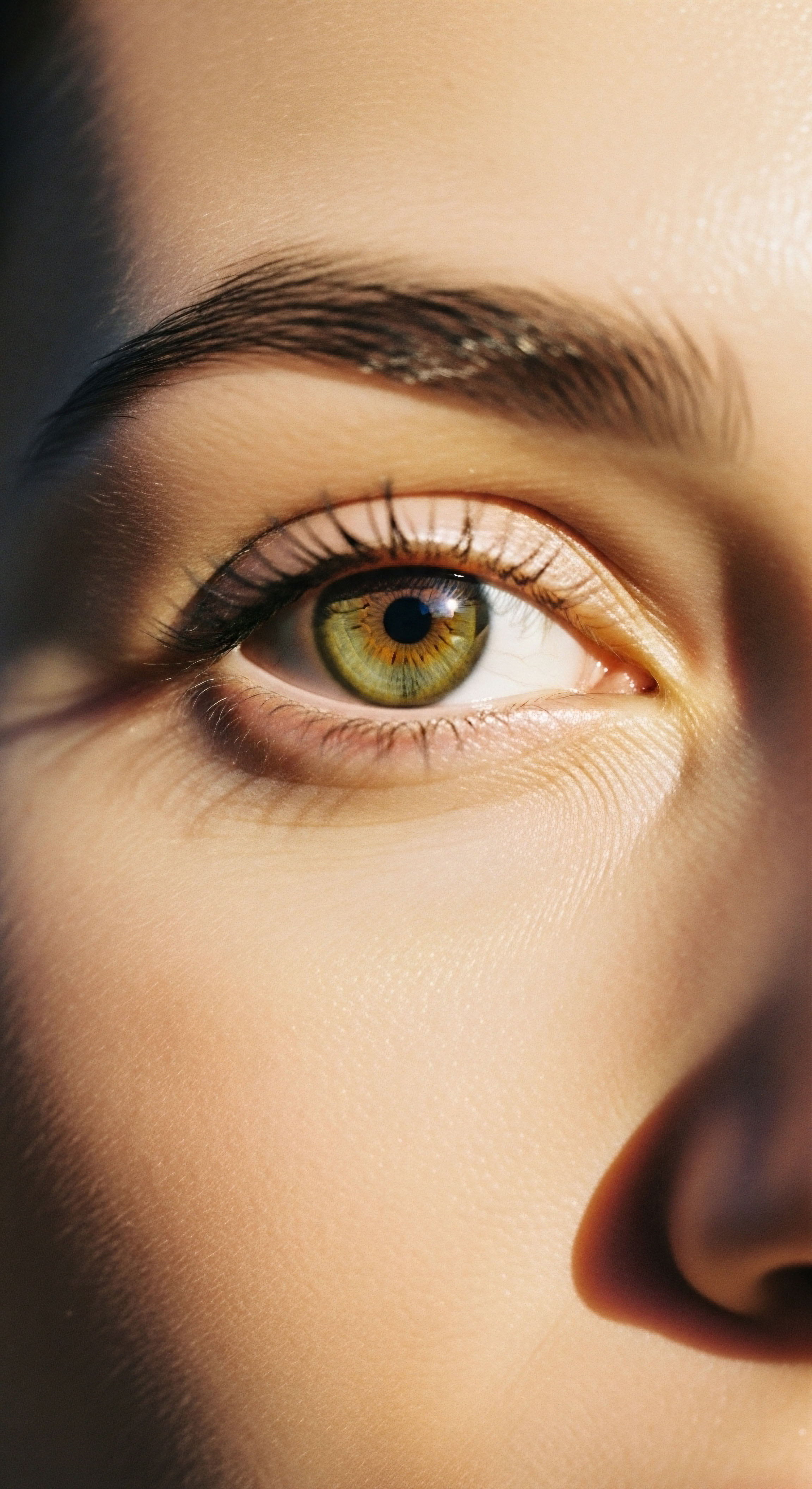

Fundamentals
You have likely arrived here holding a question that feels both simple and deeply personal. You observe the changes in your skin—a loss of firmness, the appearance of fine lines—and you seek the most effective path toward restoring its vitality. The conversation around skin beauty often presents a choice between two powerful modalities ∞ hormonal optimization Meaning ∞ Hormonal Optimization is a clinical strategy for achieving physiological balance and optimal function within an individual’s endocrine system, extending beyond mere reference range normalcy. protocols, a systemic approach that nurtures the body from within, and retinoids, a topical application that directly targets the skin’s surface. Your inquiry deserves an answer that respects the biological complexity of your own body.
The starting point is understanding that your skin is an outward expression of your internal endocrine health. It is a living organ that communicates its status, and its appearance is directly tethered to the intricate messaging system of your hormones.
This exploration begins with a validation of your experience. The subtle shifts you notice in the mirror are real, and they are rooted in physiological changes that occur over time. The journey to vibrant skin is a journey into understanding your own biology. We will first establish a clear picture of how your skin is constructed and how it maintains itself.
Following that, we will examine the profound influence of your body’s own chemical messengers—estrogen, progesterone, and testosterone—on this vital organ. Finally, we will introduce the mechanism of retinoids, explaining how they function at the cellular level when applied to the skin’s surface. This foundational knowledge will equip you to understand the deeper clinical science behind each approach.

The Architecture of Healthy Skin
To appreciate how any intervention works, we must first understand the system it intends to support. Your skin is a sophisticated, multi-layered structure. The outermost layer, the epidermis, acts as your primary environmental shield. Beneath it lies the dermis, a dense, resilient layer that provides the skin’s structural integrity.
The dermis is a matrix rich with collagen and elastin fibers, blood vessels, and nerve endings. Collagen provides firmness and strength, acting like the scaffolding of a building. Elastin, as its name suggests, provides elasticity, allowing the skin to stretch and return to its original shape. This dermal layer is where the visible signs of aging originate. When the integrity of this collagen and elastin network diminishes, the skin loses its youthful suppleness and structure.
The health of the dermis is dependent on a constant process of renewal and repair, orchestrated by specialized cells called fibroblasts. These fibroblasts are the factories that synthesize new collagen and elastin. Their productivity is not constant; it is regulated by a host of signaling molecules, with hormones being among the most powerful. The moisture content of your skin, which contributes to its plumpness and smooth texture, is also regulated at a deep level, influenced by molecules like hyaluronic acid, whose production is also tied to hormonal signals.

Hormones the Body’s Internal Architects of Skin Health
Your endocrine system functions as the body’s internal communication network, using hormones as chemical messengers to regulate countless physiological processes, including the health and appearance of your skin. These are not abstract influences; they are direct biological instructions that dictate cellular behavior. For women, the primary hormones governing skin vitality are estrogen, progesterone, and even small amounts of testosterone. Their collective balance is what sustains the skin’s structural integrity Peptide modifications extend therapeutic action, yet require careful long-term safety assessment for immune responses and systemic effects. and youthful function.

Estrogen the Master Regulator of Skin Fullness and Hydration
Estrogen is a profoundly important hormone for cutaneous health. Specific estrogen receptors are present on dermal fibroblasts Meaning ∞ Dermal fibroblasts are the primary cellular components residing within the dermis, the foundational layer of skin beneath the epidermis. and keratinocytes, the primary cells of the epidermis. When estrogen binds to these receptors, it sends a direct signal to the fibroblasts to increase the production of both collagen and hyaluronic acid. This dual action results in skin that is thicker, firmer, and better hydrated.
As estrogen levels naturally decline, particularly during perimenopause Meaning ∞ Perimenopause defines the physiological transition preceding menopause, marked by irregular menstrual cycles and fluctuating ovarian hormone production. and post-menopause, this vital signaling diminishes. Fibroblasts become less productive, leading to a measurable decrease in collagen content and skin thickness. This process contributes directly to the development of fine lines, wrinkles, and increased skin dryness.

Progesterone a Partner in Skin Elasticity
Progesterone works in concert with estrogen to maintain skin health. It contributes to skin elasticity Meaning ∞ Skin elasticity refers to the dermis’s capacity to return to its original form following stretching, pinching, or deformation. and has been shown to have a positive impact on the firmness of the skin. Progesterone also plays a role in regulating sebum (oil) production. A healthy balance of progesterone supports proper skin hydration and texture.
Its decline can contribute to the dryness and loss of tone that many women experience with age. Systemic support that considers progesterone levels is therefore a key component of a holistic approach to skin wellness.

Testosterone the Unsung Hero of Skin Thickness
While often associated with male physiology, testosterone is a vital hormone for women as well, playing a critical role in maintaining skin’s structural integrity. Testosterone supports skin thickness and contributes to collagen production. In women, maintaining optimal levels of testosterone is associated with firmer, more resilient skin.
Low-dose testosterone therapy, as part of a comprehensive hormonal optimization protocol, can help preserve this thickness and tone, addressing a component of skin aging Meaning ∞ Skin aging describes the cumulative biological and structural changes occurring in the integumentary system over time, stemming from intrinsic chronological processes and extrinsic environmental factors. that is often overlooked. It is the synergy between estrogen, progesterone, and testosterone that creates the biochemical environment for truly healthy skin.

Retinoids a Topical Catalyst for Cellular Renewal
Having understood the internal drivers of skin health, we now turn our attention to the external approach. Retinoids, which are derivatives of Vitamin A, represent one of the most well-researched topical treatments in dermatology. The most potent prescription form is tretinoin.
When applied to the skin, tretinoin does not simply sit on the surface. It penetrates to the cellular level to initiate specific changes.
The primary mechanism of tretinoin involves binding to retinoic acid receptors (RARs) located within skin cells. This binding process acts as a switch, activating genes responsible for cell growth and differentiation. This activation leads to a significant increase in epidermal cell turnover. Old, potentially damaged cells are shed more rapidly, and new, healthy cells take their place.
This process helps to improve skin texture and tone. Simultaneously, and of great importance to skin structure, tretinoin sends a powerful signal to the dermal fibroblasts, stimulating them to produce new collagen. It specifically upregulates the synthesis of type I and type III collagen, the primary forms responsible for the skin’s structural support. Furthermore, it inhibits the production of matrix metalloproteinases (MMPs), which are enzymes that actively break down existing collagen. This dual action of building new collagen while protecting existing collagen makes retinoids a powerful tool for addressing fine lines and wrinkles from the outside.
The choice between systemic hormonal support and topical retinoid application is a decision between rebuilding the body’s foundational architecture from within and accelerating the skin’s own renewal processes from the surface.
Understanding these distinct yet complementary mechanisms is the first step. Hormonal protocols address the systemic environment that allows skin cells to function optimally. Retinoids provide a direct, localized command to those cells to increase their reparative activities. The question of which is “better” becomes less about a simple comparison and more about understanding which system, internal or external, requires the most immediate and targeted support for your individual biology.


Intermediate
Advancing from the foundational principles of skin biology, we now enter the realm of clinical application. This section is designed for the individual who understands the ‘what’ and is now asking ‘how’. How are these powerful modalities—hormonal optimization and topical retinoids—practically implemented? What do the protocols look like, and what is the clinical reasoning behind them?
We will move from the general to the specific, examining the precise therapeutic agents used, typical dosages, and the biological objectives of each protocol. The focus here is on translating scientific knowledge into a clear understanding of the treatment process itself, providing you with the vocabulary and context to engage with clinical guidance in an informed way.
The discussion will be segmented into two primary pathways ∞ systemic support through hormonal replacement therapy (HRT) and topical intervention with prescription retinoids. Within HRT, we will explore the nuanced protocols for women, including the roles of estradiol, progesterone, and low-dose testosterone. We will then detail the application and titration of topical tretinoin. This comparative exploration will illuminate the distinct methodologies, timelines, and expected physiological responses associated with each approach, allowing for a more sophisticated evaluation of their respective roles in a personalized wellness strategy.

Clinical Protocols for Systemic Hormonal Optimization
A systemic approach to skin beauty is predicated on the principle that skin health is a direct reflection of overall endocrine balance. The goal of hormonal optimization is to restore the body’s internal signaling environment to one that promotes cellular vitality, not just in the skin, but throughout the body. The protocols are highly personalized, based on comprehensive lab work and a thorough evaluation of individual symptoms. For women, this typically involves a carefully balanced combination of bioidentical hormones.

Estradiol and Progesterone the Foundational Balance
For perimenopausal and postmenopausal women, the cornerstone of HRT is often the restoration of estradiol, the most potent form of estrogen. This is typically administered via transdermal creams or patches, which allow for steady absorption and minimize stress on the liver. The clinical objective is to re-establish estrogen levels that support collagen synthesis, skin thickness, and hydration. The dosage is carefully titrated based on follow-up lab testing and the patient’s response, aiming for a physiological level that alleviates symptoms and promotes well-being.
Progesterone is an essential component of this balancing act, particularly for women with an intact uterus, as it protects the uterine lining. It is typically prescribed as a daily oral capsule or a topical cream. Beyond its protective role, progesterone contributes to skin elasticity and hydration. The use of bioidentical progesterone, which is molecularly identical to the hormone produced by the body, is a key aspect of modern protocols.

The Role of Low-Dose Testosterone in Female Protocols
The inclusion of testosterone in female hormone protocols is a critical, often overlooked, element for achieving optimal outcomes in skin and overall health. Testosterone contributes significantly to skin firmness and the integrity of the dermal matrix. In our clinical practice, we utilize Testosterone Cypionate, administered via subcutaneous injection. This method ensures precise dosing and consistent blood levels.
A typical starting protocol for a woman might be 10-20 units (which translates to 0.1-0.2ml of a 200mg/ml solution) administered subcutaneously once per week. This low dose is designed to bring testosterone levels into the optimal physiological range for a female, enhancing skin tone, muscle definition, and energy levels without masculinizing side effects. The potential for side effects like acne or hair changes is carefully monitored and managed through dose adjustments.
Systemic hormonal optimization is a process of recalibrating the body’s entire signaling network to support cellular health from the inside out.
The table below outlines a sample comparison of different hormonal delivery methods, highlighting the clinical rationale for each.
| Hormone & Delivery Method | Clinical Rationale | Typical Administration | Key Considerations |
|---|---|---|---|
| Transdermal Estradiol | Provides steady hormone levels, bypasses initial liver metabolism, mimics natural release. | Daily cream or patch application. | Site rotation is recommended to ensure consistent absorption and prevent skin irritation. |
| Oral Progesterone | Offers systemic benefits and endometrial protection. Can also promote restful sleep. | Once daily capsule, typically at bedtime. | Must be bioidentical (micronized progesterone) for optimal safety profile. |
| Subcutaneous Testosterone Cypionate | Allows for precise, low-dose administration with excellent bioavailability. Supports skin and muscle tone. | Weekly self-injection (e.g. 0.1-0.2ml). | Requires careful monitoring of blood levels to maintain optimal female range and avoid side effects. |
| Testosterone Pellet Therapy | Long-acting option providing sustained hormone release over several months. | In-office insertion of pellets under the skin. | Dosing is less flexible once inserted. May be combined with an aromatase inhibitor like Anastrozole if needed. |

Clinical Protocols for Topical Retinoid Therapy
The topical pathway with retinoids represents a direct intervention at the site of concern—the skin itself. The goal is to stimulate cellular processes that have slowed with age. Tretinoin is the most potent and well-studied retinoid for this purpose, and its use requires a disciplined, gradual approach to allow the skin to adapt.

Initiating and Titrating Tretinoin
A core principle of tretinoin therapy is to “start low and go slow.” This is to manage the common initial side effect of retinization, which can include redness, peeling, and irritation as the skin adapts to the increased cell turnover. A typical starting concentration is 0.025% cream or gel.
- Initial Phase (Weeks 1-4) ∞ Application is usually limited to two or three times per week. A pea-sized amount is sufficient for the entire face and is applied at night to clean, dry skin. Applying a moisturizer before or after the tretinoin can help buffer its effects and reduce irritation.
- Adaptation Phase (Weeks 5-12) ∞ As the skin’s tolerance increases, the frequency of application can be gradually increased to every other night, and then to every night as tolerated. The signs of retinization typically subside during this period.
- Maintenance Phase (Month 3+) ∞ Once daily application is established, the individual may consider titrating up to a higher concentration, such as 0.05% or 0.1%, for enhanced efficacy, particularly for more significant signs of photoaging. This step should only be taken once the skin has fully acclimated to the lower strength.
The table below compares different strengths of topical tretinoin.
| Tretinoin Strength | Primary Use Case | Typical User Profile | Key Clinical Notes |
|---|---|---|---|
| 0.025% | Initial treatment for photoaging and acne. Good for sensitive skin. | Beginners to retinoid therapy or those with easily irritated skin. | Focus is on building tolerance and minimizing initial retinization. |
| 0.05% | Standard maintenance dose for most users. Effective for fine lines and texture. | Individuals who have successfully acclimated to 0.025% and seek greater efficacy. | Represents a good balance of efficacy and tolerability for long-term use. |
| 0.1% | Higher-strength treatment for more significant photoaging or stubborn acne. | Experienced retinoid users with resilient skin. | Offers the highest potency with an increased potential for irritation. Requires careful monitoring. |

How Do You Determine the Right Path for Your Skin?
Choosing between a systemic and a topical approach, or deciding to combine them, is a clinical decision that must be rooted in a comprehensive evaluation of your unique physiology. An individual experiencing systemic symptoms of hormonal decline—such as fatigue, mood changes, or metabolic shifts—in addition to skin changes, may find that an HRT protocol offers more holistic benefits. The improvements in skin quality become a welcome outcome of restoring overall systemic wellness.
Conversely, a person with excellent systemic health who is primarily concerned with localized signs of sun damage may find that a targeted topical retinoid is a sufficient and highly effective intervention. Often, the most powerful results are achieved through an integrated approach, where hormonal optimization builds the foundation for healthy skin from within, and topical retinoids enhance and accelerate the results on the surface.
Academic
In this final section, we transition to a discussion of the molecular and systems-level biology that underpins the clinical effects of hormonal optimization and retinoid therapy. This academic exploration is for the individual who seeks to understand the deepest layers of the science, moving beyond clinical protocols to the intricate biochemical pathways involved. We will dissect the mechanisms of action at the level of gene transcription, receptor binding, and enzymatic regulation. The central thesis is that while both HRT and retinoids are effective, they operate on fundamentally different levels of biological organization.
HRT functions as a systemic regulator, modulating the entire physiological canvas upon which the skin exists. Retinoids act as potent, localized transcription factors, directly altering the genetic expression of the cells they contact. Understanding this distinction is the key to a sophisticated appreciation of their respective powers.

Systemic Regulation the Endocrinological Basis of Skin Homeostasis
The skin is an endocrine organ, both responding to and producing hormones. Its homeostasis is inextricably linked to the Hypothalamic-Pituitary-Gonadal (HPG) axis. The decline in ovarian estrogen production during menopause is not an isolated event; it is a systemic shift that alters the biochemical environment of the entire body. The effects on skin are a direct consequence of the loss of estrogenic signaling on specific nuclear receptors within skin cells.

Estrogen Receptor Signaling in Dermal Fibroblasts
Human dermal fibroblasts express both Estrogen Receptor Alpha (ERα) and Estrogen Receptor Beta (ERβ). When estradiol binds to these receptors, the receptor-ligand complex translocates to the nucleus and binds to specific DNA sequences known as Estrogen Response Elements (EREs) in the promoter regions of target genes. This binding event initiates the transcription of genes coding for procollagen type I and type III. The result is a direct, gene-level command to increase the synthesis of the skin’s primary structural proteins.
Furthermore, estrogen signaling has been shown to down-regulate the expression of matrix metalloproteinases (MMPs), particularly MMP-1 (collagenase), the enzyme responsible for degrading type I collagen. Therefore, estrogen’s benefit is twofold ∞ it stimulates new collagen production and simultaneously protects existing collagen from degradation. This systemic hormonal influence maintains the structural integrity of the dermis on a continuous basis.
The decline in estrogen removes this constant trophic, or growth-promoting, signal. Fibroblast activity wanes, and the balance shifts in favor of collagen degradation. Hormone Replacement Therapy Meaning ∞ Hormone Replacement Therapy, often referred to as HRT, involves the administration of exogenous hormones to supplement or replace endogenous hormones that are deficient or absent in the body. effectively reinstates this signaling pathway, restoring the genetic and enzymatic environment that favors dermal matrix synthesis and preservation.

Topical Intervention the Pharmacodynamics of Tretinoin
Topical tretinoin operates through a different, though equally powerful, set of nuclear receptors ∞ the Retinoic Acid Receptors (RARs) and Retinoid X Receptors (RXRs). Tretinoin primarily shows high affinity for RARs (alpha, beta, and gamma), which are ubiquitously expressed in epidermal keratinocytes and dermal fibroblasts. Its mechanism is a clear example of targeted pharmacological intervention in gene expression.

RAR-Mediated Gene Transcription and Collagen Synthesis
Upon diffusing through the cell membrane, tretinoin binds to cytosolic RARs. This complex then moves into the nucleus, forms a heterodimer with an RXR, and binds to Retinoic Acid Response Elements (RAREs) on the DNA. This action has several critical downstream effects:
- Increased Procollagen Synthesis ∞ The binding of the tretinoin-RAR/RXR complex to RAREs in the promoter region of the COL1A1 and COL1A2 genes directly stimulates the transcription of type I procollagen. Studies have demonstrated significant increases in procollagen I formation in tretinoin-treated skin.
- Inhibition of AP-1 Pathway ∞ Tretinoin has been shown to block the signaling pathway of Activator Protein-1 (AP-1). AP-1 is a transcription factor that is activated by UV radiation and is a potent inducer of MMPs. By inhibiting AP-1, tretinoin prevents the UV-induced breakdown of collagen, a key mechanism in photoaging.
- Normalization of Keratinocyte Differentiation ∞ Tretinoin modulates the expression of various keratins, promoting a more organized and compact stratum corneum and a thicker, healthier epidermis. This increased epidermal thickness provides better structural support and reduces the appearance of fine lines.
The fundamental distinction lies in the scope of influence systemic hormonal therapy recalibrates the entire physiological operating system, while topical retinoids execute a precise, localized software update on cellular function.
This deep mechanistic understanding reveals why these two therapies can be so synergistic. HRT restores the foundational, system-wide capacity for tissue repair and maintenance. It ensures the fibroblasts are healthy, responsive, and functioning within a supportive biochemical milieu.
Topical tretinoin then provides a potent, direct stimulus to these well-supported cells, pushing them to maximize their collagen-producing potential. It is the combination of a well-functioning system and a targeted command that often yields the most profound and durable results in skin rejuvenation.

What Are the Limits of Each Approach When Considered Separately?
When considered in isolation, each modality has inherent limitations defined by its mechanism of action. Hormonal therapy’s effects are systemic and diffuse; while it improves the baseline health of the skin, it may not be sufficient to reverse decades of localized sun damage as effectively as a targeted therapy. Its primary strength is in preventing and slowing the hormonally-driven aspects of aging. Topical retinoids, on the other hand, are limited by their depth of penetration and localized action.
While exceptionally powerful for improving the epidermis and superficial dermis of the treated area, they do not address the systemic hormonal deficiencies that may be contributing to bone loss, metabolic changes, or vascular health, all of which indirectly affect skin quality. A truly comprehensive anti-aging strategy must therefore consider both the systemic foundation and the targeted surface treatment.
References
- Verdier-Sévrain, S. & Bonte, F. (2007). Skin hydration ∞ a review on its molecular mechanisms. Journal of Cosmetic Dermatology, 6 (2), 75-82.
- Thornton, M. J. (2013). Oestrogen functions in skin and skin appendages. Expert Opinion on Therapeutic Targets, 17 (9), 1035-1049.
- Raine-Fenning, N. J. Brincat, M. P. & Muscat-Baron, Y. (2003). Skin aging and menopause ∞ the role of estrogen. Gynecological Endocrinology, 17 (4), 287-293.
- Stevenson, S. & Thornton, J. (2007). Effect of estrogens on skin aging and the potential role of SERMs. Clinical Interventions in Aging, 2 (3), 283–297.
- Brincat, M. P. Baron, Y. M. & Galea, R. (2005). Estrogens and the skin. Climacteric, 8 (2), 110-123.
- Glaser, D. A. & Rogers, C. J. (2004). A new look at the safety and efficacy of testosterone therapy in women. Journal of the American Academy of Dermatology, 51 (1), 123-131.
- Mukherjee, S. Date, A. Patravale, V. Korting, H. C. Roeder, A. & Weindl, G. (2006). Retinoids in the treatment of skin aging ∞ an overview of clinical efficacy and safety. Clinical Interventions in Aging, 1 (4), 327–348.
- Yin, S. & Pignolo, R. J. (2011). The multifaceted role of retinoic acid in skeletal biology. Current Topics in Developmental Biology, 95, 281-314.
- Schmidt, J. B. Binder, M. Macheiner, W. & Bieglmayer, C. (1996). Treatment of skin aging with topical estrogens. International Journal of Dermatology, 35 (9), 669-674.
- Zasada, M. & Budzisz, E. (2019). Retinoids ∞ active molecules influencing skin structure formation in cosmetic and dermatological treatments. Postepy Dermatologii i Alergologii, 36 (4), 392–397.
Reflection
You have now journeyed through the science of skin, from its basic architecture to the intricate dance of hormones and the targeted action of retinoids. This knowledge serves a distinct purpose ∞ it empowers you to reframe the conversation you have with yourself about your own body. The question you started with, “Which is better?”, can now be transformed. A more insightful inquiry might be, “What does my body need to restore its own innate capacity for health and vitality?” You are now equipped to see the signs your skin shows you not as mere surface flaws, but as communications from a complex, interconnected system.

A Shift in Perspective
Consider the information presented here as a map. It details the different routes available, showing how one path works from within the very core of your physiology, while another provides powerful tools to resurface and rebuild from the outside. The map gives you the lay of the land, but it does not choose your destination.
That remains a uniquely personal decision, one best made in partnership with clinical guidance that is tailored to your specific biological markers and life experience. The ultimate goal is to move beyond a reactive stance to skin care and toward a proactive, deeply personal protocol for whole-system wellness, where radiant skin is a natural and expected outcome of a body in balance.



















